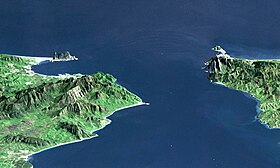Ceuta
Ceuta
سَبْتَة | ||
|---|---|---|
View of Ceuta Palace of the Assembly | ||
|
Senate 2 senators (out of 264) | | |
| Currency | Euro (€) (EUR) | |
| Website | www.Ceuta.es | |
Ceuta ( coast.
Bordered by Morocco, it lies along the boundary between the
Ceuta, like
Names
The name Abyla has been said to have been a Punic name ("Lofty Mountain"[10] or "Mountain of God") for Jebel Musa,[11] the southern Pillar of Hercules.[12] The name of the mountain was in fact Habenna (Punic: 𐤀𐤁𐤍, ʾbn, "Stone" or "Stele") or ʾAbin-ḥīq (𐤀𐤁𐤍𐤇𐤒, ʾbnḥq, "Rock of the Bay"), about the nearby Bay of Benzú.[13] The name was hellenized variously as Ápini (Greek: Ἄπινι),[13] Abýla (Ἀβύλα), Abýlē (Ἀβύλη), Ablýx (Ἀβλύξ), and Abilē Stḗlē (Ἀβίλη Στήλη, "Pillar of Abyla")[12] and in Latin as Abyla Mons ("Mount Abyla") or Abyla Columna ("the Pillar of Abyla").
The settlement below Jebel Musa was later renamed for the seven hills around the site, collectively referred to as the "Seven Brothers"
History
Ancient
Controlling access between the
After
Medieval
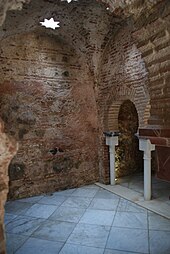

After the death of Julian, sometimes also described as a king of the
Chaos ensued with the fall of the Caliphate of Córdoba in 1031. Following this, Ceuta and Muslim Iberia were controlled by successive North African dynasties. Starting in 1084, the
Portuguese



On the morning of 21 August 1415, King
John's son
From 1415 to 1437, Pedro de Meneses became the first governor of Ceuta.
The
Under
Possession of Ceuta indirectly led to further Portuguese expansion. The main area of Portuguese expansion, at this time, was the coast of the Maghreb, where there was grain, cattle, sugar, and textiles, as well as fish, hides, wax, and honey.[24]
Ceuta had to endure alone for 43 years, until the position of the city was consolidated with the taking of
The city was recognized as a Portuguese possession by the Treaty of Alcáçovas (1479) and by the Treaty of Tordesillas (1494).
In the 1540s the Portuguese began building the Royal Walls of Ceuta as they are today including bastions, a navigable moat and a drawbridge. Some of these bastions are still standing, like the bastions of Coraza Alta, Bandera and Mallorquines.[25]
Luís de Camões lived in Ceuta between 1549 and 1551, losing his right eye in battle, which influenced his work of poetry Os Lusíadas.
Iberian Union
In 1578 King
- Infanta Catarina, Duchess of Braganza
- António, Prior of Crato
- Philip II of Spain, uncle of former King Sebastian of Portugal
Philip prevailed and was crowned King
During the Iberian Union, 1580 to 1640, Ceuta attracted many settlers of Spanish origin[27] and became the only city of the Portuguese Empire that sided with Spain when Portugal regained its independence in the Portuguese Restoration War of 1640.
Spanish


On 1 January 1668, King
The city was attacked by Moroccan forces under
During the Napoleonic Wars (1803-1815), Spain allowed Britain to occupy Ceuta. Occupation began in 1810, with Ceuta being returned at the conclusion of the wars.[29]
Disagreements regarding the border of Ceuta resulted in the

In July 1936, General
The Llano Amarillo monument was erected to honor Francisco Franco, it was inaugurated on 13 July 1940. The tall obelisk has since been abandoned, but the shield symbols of the Falange and Imperial Eagle remain visible.[31]
Following the 1947 Partition of India, a substantial number of Sindhi Hindus from current-day Pakistan settled in Ceuta, adding to a small Hindu community that had existed in Ceuta since 1893, connected to Gibraltar's.[32]
When Spain recognized the independence of
Culturally, modern Ceuta is part of the Spanish region of
On 5 November 2007, King
Since 2010, Ceuta (and Melilla) have declared the
Geography
Ceuta is separated by 17 km (11 mi)
Important Bird Area
The Ceuta Peninsula has been recognised as an
Climate
Ceuta has a maritime-influenced
| Climate data for Ceuta, 2003-2010 | |||||||||||||
|---|---|---|---|---|---|---|---|---|---|---|---|---|---|
| Month | Jan | Feb | Mar | Apr | May | Jun | Jul | Aug | Sep | Oct | Nov | Dec | Year |
| Record high °C (°F) | 21.7 (71.1) |
25.5 (77.9) |
27.9 (82.2) |
28.4 (83.1) |
33.7 (92.7) |
35.3 (95.5) |
40.2 (104.4) |
38.9 (102.0) |
34.8 (94.6) |
33.1 (91.6) |
27.2 (81.0) |
25.6 (78.1) |
40.2 (104.4) |
| Mean daily maximum °C (°F) | 15.8 (60.4) |
15.9 (60.6) |
17.4 (63.3) |
19.1 (66.4) |
21.9 (71.4) |
25.7 (78.3) |
28.9 (84.0) |
28.5 (83.3) |
25.8 (78.4) |
22.8 (73.0) |
18.8 (65.8) |
16.4 (61.5) |
21.4 (70.5) |
| Daily mean °C (°F) | 13.4 (56.1) |
13.7 (56.7) |
14.8 (58.6) |
16.4 (61.5) |
18.8 (65.8) |
22.3 (72.1) |
24.9 (76.8) |
25.0 (77.0) |
22.8 (73.0) |
20.2 (68.4) |
16.4 (61.5) |
14.3 (57.7) |
18.6 (65.4) |
| Mean daily minimum °C (°F) | 11.0 (51.8) |
11.4 (52.5) |
12.2 (54.0) |
13.6 (56.5) |
15.7 (60.3) |
18.8 (65.8) |
20.9 (69.6) |
21.5 (70.7) |
19.8 (67.6) |
17.5 (63.5) |
14.0 (57.2) |
12.1 (53.8) |
15.7 (60.3) |
| Record low °C (°F) | 1.3 (34.3) |
4.4 (39.9) |
7.2 (45.0) |
9.0 (48.2) |
10.5 (50.9) |
7.2 (45.0) |
16.3 (61.3) |
18.0 (64.4) |
15.3 (59.5) |
12.2 (54.0) |
7.4 (45.3) |
6.3 (43.3) |
1.3 (34.3) |
| Average precipitation mm (inches) | 122 (4.8) |
145 (5.7) |
90 (3.5) |
57 (2.2) |
21 (0.8) |
3 (0.1) |
1 (0.0) |
3 (0.1) |
37 (1.5) |
82 (3.2) |
127 (5.0) |
161 (6.3) |
849 (33.2) |
| Average precipitation days (≥ 1 mm) | 8 | 9 | 6 | 6 | 4 | 1 | 0 | 0 | 2 | 7 | 7 | 10 | 60 |
| Average relative humidity (%)
|
72 | 75 | 68 | 71 | 66 | 67 | 61 | 70 | 72 | 75 | 73 | 73 | 70 |
| Source: Agencia Estatal de Meteorología[43]
| |||||||||||||
Government and administration
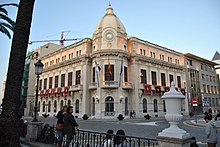
Since 1995, Ceuta is, along with
Ceuta is known officially in Spanish as Ciudad Autónoma de Ceuta (English: Autonomous City of Ceuta), with a rank between a standard
Since 1979, Ceuta has held elections to its 25-seat assembly every four years. The leader of its government was the Mayor until the Autonomy Statute provided for the new title of
Owing to its small population, Ceuta elects only one member of the
Ceuta is subdivided into 63 barriadas ("neighborhoods"), such as Barriada de Berizu, Barriada de P. Alfonso, Barriada del Sarchal, and El Hacho.[47][48][49]
Ceuta maintains its own police force.
Defence and Civil Guard
The defence of the enclave is the responsibility of the Spanish Armed Forces' General Command of Ceuta (COMGECEU).[50] The Spanish Army's combat components of the command include:
- 54th Regulares Infantry Regiment based in González Tablas barracks;
- 2nd Tercio Duke of Alba Regiment of the Spanish Legion based in the Seraglio-Recarga cantonment;
- 3rd "Montesa" Cavalry Regiment (RC-3) located in the Colonel Galindo barracks and equipped with Leopard 2 main battle tanks and Pizarro infantry fighting vehicles[51]
- 30th Mixed Artillery Regiment, one group equipped with 155/52mm towed howitzers and the other with Mistral short-range SAMs and 35/90 SKYDOR/35/90 GDF-007 anti-aircraft guns fulfilling an air defence role;[52] and,
- 7th Engineer Regiment
The command also includes its headquarters battalion as well as logistics elements.[50]
In 2023, the Spanish Navy replaced the Aresa-class patrol boat P-114 in the territory with the Rodman-class patrol boat Isla de León.[53]
Ceuta itself is only 113 km (70 mi) distant from the main Spanish naval base at
The Civil Guard is responsible for border security and protects both the territory's fortified land border as well as its maritime approaches against frequent, and sometimes significant, migrant incursions.[54]
Economy
The official currency of Ceuta is the
Transport
The city's Port of Ceuta receives high numbers of ferries each day from Algeciras in Andalusia in the south of Spain. The closest airport is Sania Ramel Airport in Morocco.
A single road border checkpoint to the south of Ceuta near Fnideq allows for cars and pedestrians to travel between Morocco and Ceuta. An additional border crossing for pedestrians exists between Benzú and Belyounech on the northern coast. The rest of the border is closed and inaccessible.
There is a bus service throughout the city, and while it does not pass into neighbouring Morocco, it services both frontier crossings.
Hospitals
The following hospitals are located within Ceuta:[60][61]
- University Hospital of Ceuta, established in 2010, 252 beds[62]
- Primary Care Emergency Services Jose Lafont
- Ceuta Medical Centre
- Spanish Military Hospital (500 beds in 1929, 2020 listed as a clinic)[63][64]
Demographics
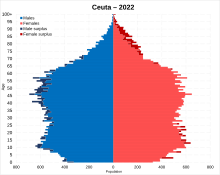
As of 2018, its population was 85,144.[65] Due to its location, Ceuta is home to a mixed ethnic and religious population. The two main religious groups are Christians and Muslims. As of 2006 approximately 50% of the population was Christian and approximately 48% Muslim.[66] As of a 2018 estimate, around 67.8% of the city's population were born in Ceuta.[67]
Spanish is the primary and official language of the enclave.[68] Moroccan Arabic (Darija) is widely spoken.[69] In 2021, the Council of Europe demanded that Spain formally recognize the language by 2023.[70]
Religion
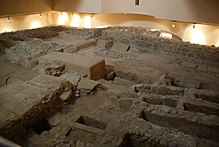
The town's Grand Mosque had been built over a
The
the union was not actually accomplished, however, until 1879.Small Jewish and Hindu minorities are also present in the city.[75]
Migration
Like Melilla, Ceuta attracts African migrants who try to use it as an entry to Europe. As a result, the enclave is surrounded by double fences that are 6 m (20 ft) high, and hundreds of migrants congregate near the fences waiting for a chance to cross them. The fences are regularly stormed by migrants trying to claim asylum once they enter Ceuta.[77]
Education
The University of Granada offers undergraduate programs at their campus in Ceuta. Like all areas of Spain, Ceuta is also served by the National University of Distance Education (UNED).
While primary and secondary education are generally offered in Spanish only, a growing number of schools are entering the Bilingual Education Program.[clarification needed]
Notable people from Ceuta
up to 1800
- Almoravidswas the great imam of that city
- Muhammad al-Idrisi (1100 in Ceuta – 1165 in Ceuta) was a Muslim geographer, cartographer and Egyptologist. He lived in Palermo at the court of King Roger II of Sicily, known for the Tabula Rogeriana.[78]
- Abu al-Abbas as-Sabti (1129 in Ceuta – 1204 in Marrakesh) the main Wali of Marrakesh
- Moses Maimonides
- Abu al-Abbas al-Azafi (1162 in Ceuta – 1236) a religious and legal scholar, member of the Banu al-Azafi who ruled Ceuta
- Mohammed ibn Rushayd (1259 in Sabta – 1321) a judge, writer and scholar of Hadith
- Álvaro of Braganza(1440–1504) a president of Council of Castile.
- George Camocke (1666–1732) a Royal Navy captain and former admiral for Spain who was exiled to Ceuta to live out the last years of his life.
- Don Upper Louisianafrom 1778 until his death.
- Brigadier General Francisco Antonio García Carrasco Díaz (1742 in Ceuta – 1813 in Lima, Peru) a Spanish soldier and Royal Governor of Chile
- Sebastián Kindelán y O'Regan (1757 in Ceuta – 1826 in Santiago de Cuba) a colonel in the Spanish Army who served as governor of East Florida 1812/1815, of Santo Domingo 1818/1821 and was provisional governor of Cuba 1822/1823
- Isabella II of Spain
since 1800
- General Francisco Llano de la Encomienda (1879 in Ceuta – 1963 in Mexico City), a Spanish soldier. During the Spanish Civil War (1936–1939) he remained loyal to the Second Spanish Republic
- General Antonio Escobar Huertas (1879 in Ceuta – executed 1940 in Barcelona), a Spanish military officer
- África de las Heras Gavilán (1909 in Ceuta – 1988 in Moscow), a Spanish Communist, naturalized Soviet citizen, and KGB spy who went by the code name Patria
- user-generated source?]
- philologistof Sephardic Jewish descent
- Manuel Chaves González(born 1945 in Ceuta), a Spanish politician of the Spanish Socialist Workers' Party. He served as the Third Vice President of the Spanish Government from 2009 to 2011
- Ramón Castellano de Torres (born 1947 in Ceuta), a Spanish artist, thought by some to be an expressionist painter
- Ignacio Velázquez Rivera (born 1953), first Mayor-President of Melilla
- Juan Jesús Vivas Lara (born 1953 in Ceuta), became the Mayor-President of Ceuta in Spain in 2001
- Pedro Avilés Gutiérrez(born 1956 in Ceuta), a Spanish novelist from Madrid.
- user-generated source?]
- Mohamed Taieb Ahmed (born 1975 in Ceuta), a Spanish-Moroccan drug lord [81] responsible for trafficking hashish across the Strait of Gibraltar and into Spain.
- Rakesh Narwani (born 1981 in Ceuta), a Spanish Filmmaker
Sport
- Francisco Lesmes (1924–2005) and Rafael Lesmes (1926–2012), brothers and Spanish footballers.
- José Martínez Sánchez (born 1945 in Ceuta), nicknamed Pirri, a retired Spanish footballer, mainly played for Real Madrid, appearing in 561 competitive games and scoring 172 goals
- José Ramón López (born 1950), a sprint canoer, silver medallist at the 1976 Summer Olympics
- Spain
- Nayim (born 1966 in Ceuta), a retired Spanish footballer; he scored a last-minute goal for Real Zaragoza in the 1995 UEFA Cup Winners' Cup Final.
- Lorena Miranda (born 1991 in Ceuta), a Spanish female water polo player, silver medallist at the 2012 Summer Olympics.
- Anuar Tuhami (born 1995 in Ceuta), a Spanish-Moroccan footballer, played one game for Morocco
Twin towns and sister cities
Ceuta is
Dispute with Morocco
The
In 1986, Spain joined the North Atlantic Treaty Organization (NATO). However, Ceuta is not under NATO protection since Article 6 of the North Atlantic Treaty limits such coverage to Europe and North America and islands north of the Tropic of Cancer. However, French Algeria was explicitly included in the treaty upon France's entry. Legal experts have claimed that other articles of the treaty could cover Spanish territories in North Africa but this interpretation has not been tested in practice.[93] During the 2022 Madrid summit, the issue of the protection of Ceuta was raised by Spain, with NATO Secretary General Jens Stoltenberg stating: "On which territories NATO protects and Ceuta and Melilla, NATO is there to protect all Allies against any threats. At the end of the day, it will always be a political decision to invoke Article 5, but rest assured NATO is there to protect and defend all Allies".[94] On 21 December 2020, following statements made by Moroccan Prime Minister Saadeddine Othmani that Ceuta is "Moroccan as the Sahara", the Spanish government summoned the Moroccan ambassador, Karima Benyaich, to convey that Spain expects all its partners to respect the sovereignty and territorial integrity of its territory in Africa and asked for an explanation for Othmani's words.[95]
See also
- AD Ceuta FC, football club
- Arab Baths in Ceuta
- Benzú
- Hotel Tryp Ceuta
- Ceuta border fence
- Ceuta and Melilla (disambiguation)
- Plazas de soberanía – Spanish exclaves on the Moroccan coast
- Porteadoras – mule ladies, bale workers
- Royal Walls of Ceuta
- Spanish Morocco
- European enclaves in North Africa before 1830
References
Citations
- ^ Municipal Register of Spain 2018. National Statistics Institute.
- ^ "Caballas". El Faro de Ceuta (in Spanish). 15 May 2011. Retrieved 22 February 2022.
- ^ caballa | Diccionario de la lengua española (in Spanish) (23.5 ed.). RAE-ASALE. 2021. Retrieved 22 February 2022.
- ^ "Contabilidad Regional de España" (PDF). www.ine.es.
- ISBN 978-1-4058-8118-0.
- ISBN 978-0-521-15255-6.
- ^ Jefatura del Estado (14 March 1995), Ley Orgánica 1/1995, de 13 de marzo, de Estatuto de Autonomía de Ceuta, pp. 8055–8061, retrieved 19 August 2023
- .
- ISBN 978-84-921390-3-3.
- ^ Cauvin & al. (1843).
- ^ Bonney & al. (1907), p. 26.
- ^ a b c Smith (1854).
- ^ a b Lipiński (2004), p. 422–425.
- ^ a b Smedley & al. (1845), p. 49.
- Geography, IV.i.5.
- ^ In, e.g., Pomponius Mela.
- ISBN 978-0-521-19677-2.
- ^ John Kitto; William Lindsay Alexander, eds. (1864). A Cyclopædia of Biblical Literature. Vol. 2. p. 350.
- ^ Dyer (1873).
- ^ Mommsen, Theodore, The Provinces of the Roman Empire, s.v. "Africa".
- ^ Gibb, Hamilton Alexander Rosskeen; Johannes Hendrik Kramers; Bernard Lewis; Charles Pellat; Joseph Schacht (1994), The Encyclopaedia of Islam, E.J. Brill, p. 690.
- ISBN 978-90-04-09834-3.
- S2CID 252936676.
- ^ "Payne, Stanley G., A History of Spain and Portugal, Vol.1, Chap.10 "The Expansion"" (PDF).
- ^ "Ceuta". fortified-places.com. Archived from the original on 17 October 2017. Retrieved 17 September 2015.
- ISBN 978-0-300-07800-8.
- ISBN 978-0-9543335-3-9. Archived from the originalon 5 March 2012. Retrieved 18 January 2010.
- ^ Britannica, The Editors of Encyclopaedia. "Ceuta". Encyclopedia Britannica. Retrieved 24 December 2022.
- ^ Chisholm, Hugh, ed. (1911). . Encyclopædia Britannica. Vol. 05 (11th ed.). Cambridge University Press. p. 777; see last eight lines.
- ^ "History of Ceuta". Archived from the original on 5 March 2012. Retrieved 1 March 2012.
- ^ "Franco monument now part of a rubbish dump in Ceuta". Archived from the original on 7 December 2012.
- ISBN 978-84-9888-523-1.
- ^ Bárbulo, Tomás (22 March 2009). "Resistir en el monte del Renegado". El País. Retrieved 17 June 2009.
- ^ "Ceuta y Melilla son España, dice Juan Carlos I; Sebta y Melilia son nuestras, responde Mohamed VI". Blogs.periodistadigital.com. 22 February 1999. Archived from the original on 18 July 2011. Retrieved 17 June 2009.
- ^ Morgan, Marcus; Bond, Paul (6 December 2007). "Royal visit revives tensions between Spain and Morocco". World Socialist Web Site. Archived from the original on 25 March 2013. Retrieved 6 January 2022.
- ^ "Muslim Holiday in Ceuta and Melilla". Spainforvisitors.com. Archived from the original on 29 September 2011. Retrieved 3 September 2011.
- ^ "Public Holidays and Bank Holidays for Spain". Qppstudio.net. Archived from the original on 30 September 2011. Retrieved 3 September 2011.
- ^ "Turismo. Ceuta, cuatro mundos por descubrir". abcViajes. Retrieved 1 February 2020.
- ISBN 978-1-61069-422-3.
- ^ "Ceuta". BirdLife Data Zone. BirdLife International. 2021. Retrieved 13 February 2021.
- ^ "Ceuta, Spain – Climate Summary". weatherbase. Retrieved 8 December 2014.
- ^ a b "Valores climatológicos normales. Ceuta" [Normal climate values. Ceuta]. AEMET (in Spanish). Agencia Estatal de Meteorología. Retrieved 11 August 2015.
- ^ "Valores extremos. Ceuta – Selector" [Extreme values. Ceuta – Selector]. AEMET (in Spanish). Agencia Estatal de Meteorología. Retrieved 16 August 2016.
- ^ "Ley Orgánica 1/1995, de 13 de marzo, Estatuto de Autonomía de Ceuta" (in Spanish). Noticias.juridicas.com. Retrieved 17 June 2009.
- ^ "Resultados Electorales en Ceuta: Elecciones Municipales 2011 en EL PAÍS" (in Spanish). EDICIONES EL PAÍS S.L. 2011. Retrieved 16 August 2016.
- ^ "Ceuta Votes for Far-Right Vox Party in Spanish General Elections". Morocco World News. 11 November 2019. Retrieved 28 January 2020.
- ^ "El servicio de Policia de Barriadas podria funcionar a partir del 15 de septiembre" [The Police Service of Barriadas could work from September 15]. El Pueblo de Ceuta (in Spanish). Archived from the original on 20 July 2011. Retrieved 17 June 2009.
- ^ "Map of Ceuta". planetware.
- ^ "Códigos postales de Ceuta en Ceuta". Codigo-postal.info. Retrieved 17 June 2009.
- ^ a b "Comandancia General de Ceuta". Spanish Ministry of Defence (in Spanish). Retrieved 14 January 2023.
- ^ "Los ceutíes conocen las unidades acorazadas de 'Montesa nº3'". El Faro de Ceuta (in Spanish). 19 July 2022. Retrieved 14 January 2023.
- ^ "Regimiento De Artilleria Mixto Nº30". Spanish Ministry of Defence (in Spanish). Retrieved 14 January 2023."Contenido - Army". Spanish Ministry of Defence (in Spanish). Retrieved 14 January 2023.
- ^ "El nuevo patrullero de la Armada Española que vigilará Ceuta y el Estrecho de Gibraltar". Defensa Aviacion."Patrol Boat P-114". Armada Española. 2020. Archived from the original on 26 February 2021. Retrieved 28 August 2023.
{{cite web}}: CS1 maint: bot: original URL status unknown (link) - ^ "Ceuta: Spain sends troops as 8,000 migrants enter enclave". BBC News. 18 May 2021. Retrieved 14 January 2023.Guerraoui, Saad (12 June 2021). "Spanish report warns of Morocco's 'hybrid strategies' to annex Ceuta, Melilla". Middle East Online. Retrieved 14 January 2023.
- ^ a b "Economic Data of Ceuta, de ceutna digital". Ceuta.es. Archived from the original on 10 April 2010. Retrieved 17 June 2009.
- ISBN 9781897643068. Retrieved 17 June 2009.
- ^ "Morocco 'mule women' in back-breaking trade from Spain enclave". 6 October 2017. Retrieved 11 May 2018.
- ^ "The economics of exclaves". 24 April 2018. Retrieved 11 May 2018.
- ^ (www.dw.com), Deutsche Welle. "Moroccan women used as 'mules' to avoid tariffs | DW | 11 May 2018". DW.COM. Retrieved 11 May 2018.
- ^ Google Maps
- ^ "Hospitals in Ceuta". Hospitals Worldguide. Retrieved 8 July 2020.
- ^ "Hospital Universitario de Ceuta". Retrieved 8 July 2020.
- ^ Port Directory of Principal Foreign Ports. 1929.
- ^ "Military Medicine in Spain". Military Medicine. Retrieved 8 July 2020.
- ^ "La población de Ceuta aumenta en un 0,2% con respecto a 2017". El Faro de Ceuta. 24 April 2018. Retrieved 8 May 2019.
- ^ Roa, J. M. (2006). "Scholastic achievement and the diglossic situation in a sample of primary-school students in Ceuta". Revista Electrónica de Investigación Educativa. 8 (1).
- ^ Redacción (20 December 2018). "El 67,8% de los habitantes actuales de Ceuta han nacido en la ciudad según los datos del INE". Ceuta Ahora (in Spanish). Retrieved 2 September 2021.
- ^ "Languages Across Europe – Spanish". BBC. 14 October 2014. Archived from the original on 5 April 2018.
- ISBN 978-1-4051-9500-3.
- ^ Goff, Shaquile. "Council of Europe Demands Ceuta, Melilla Recognize Arabic, Darija by 2023". Morocco World News. Retrieved 26 May 2022.
- ^ Villada, Fernando. "Ceuta huellas del cristianismo en Ceuta". academia.edu. Retrieved 10 September 2017.
- ^ "Catholic Encyclopedia: Tingis". Newadvent.org. 1 July 1912. Retrieved 8 August 2010.
- [self-published]
- ^ "Catholic Encyclopedia: Cadiz". Newadvent.org. 1 November 1908. Retrieved 8 August 2010.
- ^ "Ceuta: Multicultural city". Al Jazeera. Archived from the original on 29 January 2020. Retrieved 28 April 2020.
- ^ a b Centro de Investigaciones Sociológicas (Centre for Sociological Research) (October 2019). "Macrobarómetro de octubre 2019, Banco de datos - Document 'Población con derecho a voto en elecciones generales y residente en España, Ciudad Autónoma de Ceuta" (PDF) (in Spanish). p. 20. Archived (PDF) from the original on 4 February 2020. Retrieved 4 February 2020.
- ^ "Hundreds of migrants storm fence to reach Spanish enclave of Ceuta". BBC. 17 February 2017.
- Beazley, Charles Raymond (1911). . Encyclopædia Britannica. Vol. 14 (11th ed.). pp. 289–290.
- ^ "Eugenio Martín". IMDb. Retrieved 14 January 2023.
- ^ "Eva Isanta". IMDb. Retrieved 14 January 2023.
- ^ "Vuelve 'El Nene'". Interviu (in Spanish). 14 January 2008. Archived from the original on 11 September 2019. Retrieved 20 October 2017.
- ^ "Listado de corporaciones locales españolas hermanadas con Europa" (PDF). Spanish Federation of Municipalities and Provinces. Archived (PDF) from the original on 3 October 2017.
- ^ Corrales, Carlos (5 August 2012). "Ceuta y Algeciras, tres lustros como ciudades hermanadas". Europa Sur.
- ^ Durio, Pablo Manuel (19 September 2009). "Cádiz tiene ya una familia más que numerosa". Diario de Cádiz.
- ^ "Ceuta, Melilla profile". BBC News. 14 December 2018. Retrieved 18 October 2020.
- ^ Parodi, Luis (27 November 2007). "Vivas visitará el jueves la Casa de Ceuta en Cádiz antes de regresar". El Pueblo de Ceuta.
- ^ https://www.bbc.co.uk/news/world-africa-57305882
- ISBN 0-85323-985-1.
- ^ Castan Pinos, J. (2014). "The Spanish-Moroccan relationship: combining bonne entente with territorial disputes". In K. Stoklosa (ed.). Living on the border. European Border Regions in Comparison. Abingdon: Routledge. p. 103.
- ISBN 978-84-92627-67-7.
- ^ Tremlett, Giles (12 June 2003). "A rocky relationship". The Guardian. London. Retrieved 17 June 2009.
- ^ François Papet-Périn (2012). La mer d'Alboran ou Le contentieux territorial hispano-marocain sur les deux bornes européennes de Ceuta et Melilla (doctorat d'histoire contemporaine soutenue thesis). Paris 1-Sorbonne. 2 volumes.
- ^ Thess Móstoles (2 October 2021). "¿Están Ceuta y Melilla bajo el paraguas de la OTAN?". Newtral (in Spanish). Retrieved 25 February 2022.
- ^ Jens Stoltenberg (30 June 2022). "Press conference by NATO Secretary General Jens Stoltenberg following the meeting of the North Atlantic Council at the level of Heads of State and Government (2022 NATO Summit)". NATO (transcript). Retrieved 14 January 2023.
- ^ "España convoca a la embajadora de Marruecos por unas declaraciones de su primer ministro sobre Ceuta y Melilla". elDiario.es (in Spanish). 21 December 2020. Retrieved 22 December 2020."Moroccan Ambassador to Spain summoned over calls for territorial sovereignty talks". AfricaNews. 22 December 2020. Retrieved 22 December 2020.
Bibliography
- Bonney, Thomas George; et al. (1907), The Mediterranean: Its Storied Cities and Venerable Ruins, New York: James Pott & Co.
- Cauvin, Joseph; et al., eds. (1843), "Abila", Lempriere's Classical Dictionary, Abridged by E.h. Barker, London: Longman, Brown, Green, & Longmans.
- Dyer, Thomas H. (1873), "Septem Fratres", A Dictionary of Greek and Roman Geography, vol. II, London: John Murray, p. 965.
- ISBN 9789042913448.
- Smedley, Edward; et al., eds. (1845), "Mauritania", Encyclopaedia Metropolitana, vol. XXII, London: B. Fellowes & al., pp. 48–49.
- Smith, Philip (1854), "Abyla", Dictionary of Greek and Roman Geography, London: Walton & Maberly.
External links
- . Encyclopædia Britannica (11th ed.). 1911.
- (in Spanish) Official Ceuta government website
- Ceuta tourism website





